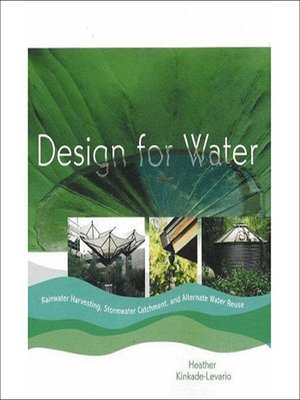Design for Water
ebook ∣ Rainwater Harvesting, Stormwater Catchment, and Alternate Water Reuse
By Heather Kinkade-Levario

Sign up to save your library
With an OverDrive account, you can save your favorite libraries for at-a-glance information about availability. Find out more about OverDrive accounts.
Find this title in Libby, the library reading app by OverDrive.



Search for a digital library with this title
Title found at these libraries:
| Library Name | Distance |
|---|---|
| Loading... |
A guide to alternate water collection for green new developments, aimed at conserving water and reusing it wisely.
In an era of dwindling resources, water is poised to become the new oil as the entire world now faces the reality of a decreasing supply of clean water. To avert a devastating shortage, we must not only look at alternate water sources for existing structures, we must also plan our new developments differently.
Design for Water is an accessible and clearly written guide to alternate water collection, with a focus on rainwater harvesting in the urban environment. The book:outlines the process of water collection from multiple sources—landscape, residential, commercial, industrial, school, park and municipal systems provides numerous case studies details the assembly and actual application of equipment includes specific details, schematics and references
All aspects of rainwater harvesting are outlined, including passive and active system set-up, storage, stormwater reuse, distribution, purification, analysis and filtration. There is even a section on rainwater harvesting for wildlife.
In addition to rainwater, there are several affordable and accessible alternate sources, including cooling tower bleed-off water, air conditioning condensate, gray water, and fog collection.
Design for Water is geared to providing those making development decisions and guidelines with the information they need to set up passive harvesting techniques. The book will especially appeal to engineers, landscape architects, municipal decision-makers, developers and land-owners.
In an era of dwindling resources, water is poised to become the new oil as the entire world now faces the reality of a decreasing supply of clean water. To avert a devastating shortage, we must not only look at alternate water sources for existing structures, we must also plan our new developments differently.
Design for Water is an accessible and clearly written guide to alternate water collection, with a focus on rainwater harvesting in the urban environment. The book:
All aspects of rainwater harvesting are outlined, including passive and active system set-up, storage, stormwater reuse, distribution, purification, analysis and filtration. There is even a section on rainwater harvesting for wildlife.
In addition to rainwater, there are several affordable and accessible alternate sources, including cooling tower bleed-off water, air conditioning condensate, gray water, and fog collection.
Design for Water is geared to providing those making development decisions and guidelines with the information they need to set up passive harvesting techniques. The book will especially appeal to engineers, landscape architects, municipal decision-makers, developers and land-owners.







